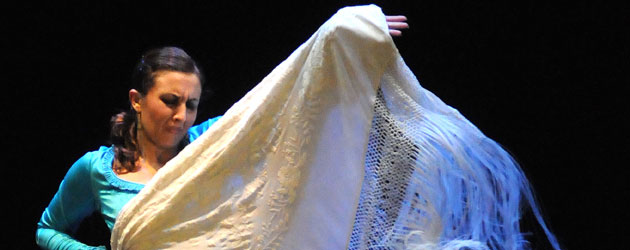Text: Estela Zatania
Photos: Ana Palma
Tuesday, February 26th, 2013. Jerez de la Frontera
Special 17th Festival de Jerez – All the information
DANCE THAT OPENS DOORS, AND THE FLAVOR OF TIMES PAST
MARÍA JOSÉ FRANCO “ABRIENDO PUERTAS”
Series: Solos en Compañía
Sala Compañía, 9:00pm
Tuesday evening at the Festival de Jerez, there was no show at the Villamarta Theater, but the program followed its course at two other regular venues, the Sala Compañía and the Palacio Villavicencio.
Dancer María José Franco (Cádiz, 1977), is practically accorded the status of being from Jerez due to her early training with Angelita Gómez, her successful artistic collaboration with the much-admired Antonio el Pipa and her family ties with the Moneos, a flamenco dynasty par excellence in a city where these things are still considered important.
Ever since leaving Pipa’s company, she’s been trying to find her own path via a series of experiments with modest results, projects presented within the program of the Festival de Jerez where she is also in demand each year to give the associated dance courses.
The title of this new work, “Abriendo Puertas”, ‘opening doors’, seems to reflect the dancer’s still unfulfilled desire to achieve something more. There is no doubt she has the technical level, and a long-waisted body very suitable for the job. She staged a contemporary siguiriya as presentation, dressed in basic black and beginning on the floor. It turned into a pas de deux with the collaboration of dancer Ximo Llorents and singing of Luis Moneo.
Singer Carmen Grilo revives the zorongo that leads into tangos for María José’s dance, and the latter deserves special mention if only because she was brave enough to wear white, and later on bright turquoise blue and then red for other dances.
After malagueña by Luis Moneo, Franco gave free rein to her Cádiz roots with classic alegrías that included harmonized singing by Moneo and Grilo that gave a retro feel, and the show came to an end with the form that most identifies Jerez, bulería por soleá.
MÁRQUEZ “EL ZAPATERO” Y ANTONIO RUIZ “EL CARPINTERO”
Series: Los conciertos de palacio
Palacio Villavicencio, 7:00pm
At the Palacio Villavicencio, “palace of flamenco singing” in terms of the Festival de Jerez, two veterans gave a wonderful recital of an hour and forty minutes of unamplified singing with forms they themselves had to have heard from people born in the nineteenth century. If that’s good or bad is something that depends entirely on each individual’s taste, but it’s not something flamenco fans get to see every day.
Márquez “El Zapatero” (Villaverde del Ariscal, c. 1930) and Antonio Ruiz “El Carpintero” (Morón de la Frontera, 1948), added a touch of realism to this festival that sometimes seems like a Disney franchise, to judge from some of the experimental or avant-garde works presented. With these two singers there was no pretense, no fancy clothes, no grand finale of bulerías. For these men, cante is a way of life, something to do at home or with friends, the occasional fiesta or performance, but always as part of the continuous thread of life.
The small room wasn’t full, but those present appreciated the value of this modest recital. The singers went on stage together…with younger singers it would have been called a “facing-off”, but these two men were united by friendship, mutual support and the shared memory of simpler times.
Admirably, the young guitar phenomenon, Dani de Morón, accompanied these veterans as if he’d never heard a modern harmony or played a picado, as if Diego del Gastor were still alive and his buddies were up at Casa Pepe rapping out compás on the wooden bar.
El Carpintero began with tangos “from Grazalema, with a special feeling” as he explained. With the guitar accompaniment in E, it was a pungent flavor that sent us to a specific time and place and recalled the voice of Luis Torres “Joselero”. Zapatero continued with bulerías por soleá “of Tomás Pavón” as he said, and he wasn’t talking about any CD. Following this, a delightful interpretation of alboreá by el Carpintero who explained how Joselero and his brother-in-law Diego were scandalized at first when they were asked to record this form only sung at weddings…these are anecdotes that add a great deal. Bulerías based on the cante of Gaspar de Utrera, so admired in Morón, and then el Zapatero (these nicknames are too much, “zapatero” means shoemaker, and “carpintero” is of course carpenter) delivered his soleá of Zurraque of the potters of Triana, a group of cantes this singer preserves and cultivates with tender loving care.
More soleá which is the heart and soul of Seville flamenco just as siguiriyas is of the province of Cádiz. “I’m gonna sing the soleá of Manuel that I heard his son Tomás sing”, and the spirit of the legendary singer Torre seemed to materialize when el Carpintero launched into these cantes. There was much more: el Zapatero sang malagueñas of Chacón and Mellizo with abandolao ending, el Carpintero did siguiriyas with the haunting sound of times past, the “soleá grande” of Triana by el Zapatero and the two singers rounded off the recital taking turns with martinete.
Nostalgia? Well of course. When it comes to cante, ”flavor” is the memory of something worthwhile you were able to enjoy long ago, and which became scarce. There’s room for everything at the Festival de Jerez.
